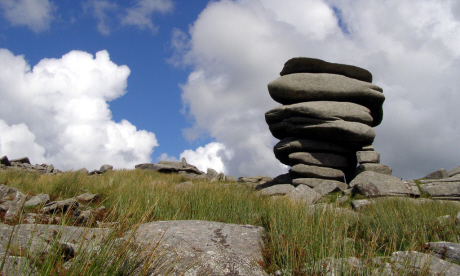
Tales of giants, mermaids and Cornish fairies – don't miss the most bizarre legends from this UK coastal county
In 1998, a team of Russian researchers from the Institute of Metahistory in Moscow claimed that they had discovered the lost city of Atlantis 100 miles off the coast of Land’s End. This drowned city lay on Little Sole Bank, a rise of land out in the Atlantic Ocean on the edge of the Celtic Shelf. The researchers at the institute had studied ancient texts, in which the Greek philosopher Plato claimed that Atlantis lay beyond the Pillars of Hercules – today’s straits of Gibraltar. The team also considered the myths of the sunken land of Lyonesse, said to have stretched from Land’s End to the Isles of Scilly and been submerged in a mighty flood at the time of King Arthur.
Cornwall has a rich body of tales in which church bells are said to ring below the waters and for centuries Cornish fishermen have reported glimpsing spires and castles beneath the waves. The Isles of Scilly are thought to be the old Lyonesse mountain tops; the last time the land was exposed was during the last Ice Age around 20,000 years ago.
How to find it: 9 miles south-west of Penzance on A30
In 1595, a fleet of Spanish ships appeared and burnt the village of Mousehole to the ground. Only the Keigwin Arms, now a private house, survived. Near the quay is a stone called Merlin’s Rock, and the Spanish attack was regarded locally as the fulfilment of a prophecy by the wizard. An old saying of the district, is: ‘There shall land on the Rock of Merlin Those who shall burn Paul, Penzance and Newlyn.’
Merlin’s other prophecies have still to be fulfilled. He said, for instance, that: ‘When the Rame Head and Dodman meet, Man and woman will have cause to greet (cry).’ The two headlands remain 40 miles apart.
Mousehole is also famous for its celebrations on Tom Bawcock’s Eve, which take place on December 23. Tom Bawcock was a legendary fisherman and widower who lived in the village during a time of terrible famine several centuries ago. Old and with little to lose, Tom braved terrible storms with his faithful cat to bring back a mighty catch for the starving villagers. The celebrations of this heroic event include a lantern procession, followed by a supper of stargazey pie – a dish of potatoes, eggs and pilchards, their heads poking out of the top, gazing at the stars. All of Mousehole harbour is illuminated with lights installed for the celebrations.
How to find it: On minor roads off B3315, 3 miles S of Penzance
The granite Men-an-Tol, or stone-and-hole, lies to the northwest of Madron, near Penzance. Originally forming the entrance to a chambered tomb, the stone was thought to possess curative powers. Even in the 20th century, it was customary for young children to be passed naked through the hole nine times as a cure for scrofula, rickets and other diseases. Pregnancy was guaranteed to married women who wriggled through backwards at full moon. It was also believed that the stone would answer questions, by means of two brass pins laid across each other near its edge. The pins would pivot of their own accord, although folklore leaves interpretation of the pins’ movement open to the observer.
The stone’s original purpose is unknown, but holed stones are not uncommon in the region. Another, the Tolven, can be seen in a garden near Helston.
How to find it: On minor roads off A30 and A3071, 1 mile N of Penzance.
The Cornish name for St Michael’s Mount is ‘Carrick luz en cuz’, which means ‘the ancient rock in the wood’. At low tide, it is possible to glimpse the fossilised remains of a forest that once covered the coastal area. Its current name dates from early Christian times, when, according to legend, St Michael himself appeared to a group of fishermen on the Mount.
In 1044, Edward the Confessor founded a chapel on the Mount; later, the Normans built a fortress there, which exists today as a magnificent castle. Within its walls is a rough-cut stone seat known as Michael’s Chair. St Keyne, on a pilgrimage to the Mount, is said to have endowed the seat with the same power that she gave to her holy well at St Keyne (page 20) – the first of a married couple to drink from the well (or sit on the seat) will dominate the partnership for life.
How to find it: St Michael’s Mount is off Marazion, S of A394, 4 miles E of Penzance. Reached on foot via causeway at low tide or ferry (summer only) at high tide.
According to one legend, the Devil was flying across Cornwall carrying a boulder to block the entrance to Hell, when he was challenged by St Michael. In the ensuing battle, the Devil dropped the rock, and the place where it fell became known as Hell’s Stone or Helston. It is said that a large rock built into the wall of the Angel Hotel in Coinagehall Street is this very stone. To celebrate St Michael’s victory over the Devil, the inhabitants danced through the streets and thereby originated the famous Furry Dance, which still takes place on the nearest Saturday to the feast day of the town’s patron saint, St Michael the Archangel (May 8). The name of the dance is possibly derived either from the Middle English word ‘ferrie’, implying a church festival, or the Celtic ‘feur’ meaning a holiday or fair. However, its seasonal setting suggests the dance may once have been a pagan spring festival.
The ceremony that precedes the Furry Dance is probably more significant than the dance itself. It is a true relic of ancient May games, designed to greet the summer with song and drama, the aim being to induce crop fertility. Known as the Hal-an-Tow, this mumming play features the older children. Garlanded and carrying branches of sycamore, they sing an ancient song, part of the chorus of which runs:
Welcome is the Summer, the Summer and the May-O,
For Summer is a-come-O, and Winter is a-gone-O.
How to find it: 6miles E of Penzance on A394.
Morgawr – Cornish for sea giant – is the name given to the monster of Falmouth Bay. This modern legend was first sighted in 1876, when fishermen out in their boat caught something strange in their net. Then a peculiar creature became tangled in fishing nets in 1926, and again in 1975 near Pendennis Point, where it was described by offshore fishermen as a hump-backed creature with horns and with bristles down its back. Several witnesses have since succeeded in photographing the creature, their blurry images evoking a lumpy Loch Ness monster. In 1999, Morgawr was caught on video by John Holmes, who had formerly worked at London’s Natural History Museum.
How to find it: At end of A39, 12 miles S of Truro.
Spectacular Tintagel Castle, perched high on precipitous cliffs above the Atlantic coastline, is suffused with myth. The island, joined to the mainland by a narrow rocky pass, is the legendary birthplace of King Arthur. It was here that King Uther Pendragon deceived the beautiful Igerna, wife of Gorlois, Earl of Cornwall. The king, with magical assistance from his wizard Merlin, disguised himself as Igerna’s husband. Entering the fortress in this guise, he seduced Igerna, who later gave birth to the boy who became King Arthur.
The castle was, in fact, built by Reginald of Cornwall, the illegitimate son of Henry I, in 1141 – long after the historical Arthur lived. At one time it belonged to Edward, Prince of Wales, otherwise known as the Black Prince after his distinctive black armour. By the mid 16th century it had fallen into disrepair. The cavern below the castle is known as Merlin’s Cave, and the wizard’s ghost is said to wander in its echoing recesses. According to another local story, Arthur himself is reincarnated in the form of the rare Cornish chough, a bird that may sometimes be seen perched on the wave-lashed cliff ledges.
How to find it: Off B3263 4 miles SW of Boscastle.
This beautiful rocky glen conceals a waterfall that cascades 12m (40ft) into a rock basin known locally as the Kieve.
The 5th century holy man St Nectan, on his deathbed, threw his silver chapel bell into this torrent. In an instant it vanished into the rock bed, and the saint declared that it would reappear only when true religion had been restored to what was, at the time, a dissident Church.
After his death the saint’s body was placed in a chest, along with the sacramental plate, and the chest was hidden in the Kieve. Hundreds of years later, according to local stories, miners tried to blast their way through the Kieve in order to recover the tresure. Their efforts led to nothing, and after much toil the miners were unsettled by the sound of a bell. This eerie tinkling was followed by a whispering, that became louder, until they could hear the words: ‘The child is not yet born who shall recover this treasure.’ The miners fled the Kieve in terror. The prophecy of the Glen has never been fulfilled.
How to find it: Inland from B3263, 2 miles NE of Tintagel.
This natural pile of granite slabs takes its name from its similarity to a cheese-press. It is associated with Daniel Gumb, a local stonecutter, whose work can still be seen in Linkinhorne churchyard. Daniel was of unusually high intelligence and, although his parents were uneducated, he taught himself mathematics, became deeply interested in astronomy and was an avid reader. He and his wife, a local girl, set up home in a cave beneath the Cheesewring, where they raised numerous children, baptising them on prehistoric altars nearby. Until the cave collapsed, many of Gumb’s intricate geometrical designs could be seen carved in the granite, with the inscription ‘D. Gumb 1735’ cut above the cave entrance.
How to find it: On minor roads off B3254, 6 miles N of Liskeard.
The sub-tropical isle of Tresco in the Scilly Isles is the mythical haunt of mermaids, particularly around Piper’s Hole, a cave on the northern coast with a freshwater pool. This cave is believed to have a legendary passage to the adjacent island of St Mary’s; apparent proof of this was provided when a Tresco dog emerged from a cave on St Mary’s.
One story says that during the Civil War (1642-51), when the Royalists held the Isles, a Roundhead avoided capture by hiding in Piper’s Hole. He was discovered by a Cavalier’s daughter who fell in love with him and arranged his escape to the mainland. After the war he returned to marry her.
How to find it: The Isles of Scilly lie 30 miles off Land’s End. Access Tresco by boat from St Mary’s or by helicopter from Penzance.
